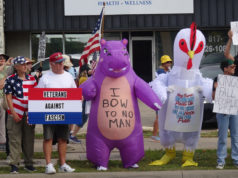The halls of the East Lancaster Avenue police substation echoed with angry accusations.
“We’ve made it easy to be homeless in Fort Worth,” one woman yelled, to the crowd’s applause.
“Kids deserve better — they shouldn’t have to step over a drunk to get on the school bus!” another resident complained and drew more cheers.![Brewer: ‘The question comes down to, will [the city] invest the resources?’](https://www.fwweekly.com/wp-content/images/stories/images/archive/2007-04-18/metro_4-18.jpg) About 70 residents and business owners from the neighborhoods surrounding the city’s cluster of homeless shelters on Lancaster Avenue turned out for the meeting last month, to tell city officials and police that they are fed up with problems caused by the shelters’ clients. Many of them, in their comments, blamed the city’s lack of response to specific problems — and the city policy that concentrates the shelters, their clients, and the agencies that serve them in their part of town. They cited chronic problems of panhandling, public drunkenness, littering, and other crimes committed by vagrants in the area. Stacie Gray said that, 13 years ago, when he moved into a modest 1950s house in the nearby Meadowbrook neighborhood, he thought it was the ideal place to buy his first home. With a fire station in the vicinity and a police substation on the way, it seemed like a safe place to live.
About 70 residents and business owners from the neighborhoods surrounding the city’s cluster of homeless shelters on Lancaster Avenue turned out for the meeting last month, to tell city officials and police that they are fed up with problems caused by the shelters’ clients. Many of them, in their comments, blamed the city’s lack of response to specific problems — and the city policy that concentrates the shelters, their clients, and the agencies that serve them in their part of town. They cited chronic problems of panhandling, public drunkenness, littering, and other crimes committed by vagrants in the area. Stacie Gray said that, 13 years ago, when he moved into a modest 1950s house in the nearby Meadowbrook neighborhood, he thought it was the ideal place to buy his first home. With a fire station in the vicinity and a police substation on the way, it seemed like a safe place to live.
It wasn’t long, however, before he noticed his neighbor’s “Yard of the Month” sign being replaced with a “No Trespassing” sign to warn away the homeless people who were roaming the area. Gray said street people have turned his dream neighborhood into a nightmare littered with trash and 40-ounce beer bottles. “I did not have this in the equation when I moved in,” Gray said. “I feel I have been let down because the homeless problem is not being handled. “Why don’t they put one of these shelters in West Fort Worth and see how they like it,” he said. Suzette Watkins, owner of Riverside Kennel and seven-year resident of the area, said she feels the concentration of shelters has exacerbated the problems. Combined with local liquor stores and obvious drug usage and trafficking, East Lancaster has become a hotspot for crime, she said. “Shelters near alcohol and drugs will never be a good combination.”
In the 1980s, Fort Worth officials made a decision to cluster all of the city’s major homeless agencies in the area just east of I-35 on Lancaster. The change helped move homeless people out of downtown — and away from tourist areas like the convention center and Sundance Square. City development director Bob Riley said the goal was to group the shelters and related service facilities together. “It made sense before to try and group those as close as possible, to increase the [ease of working] with that population,” he said. A large portion of the city’s estimated 4,000 homeless persons — a population that has dropped by about 4 percent in the last year — now congregate there. In the ensuing years, however, those who live and work near the shelters feel that the city has simply moved the homeless population out of downtowners’ sight — and into their front yards. They say that the police department’s failure to respond to calls and make arrests has created huge problems.
Police Chief Ralph Mendoza, who called the meeting to hear residents’ concerns, said his officers will do better — and that he’s ready to work with the community on a plan to improve the situation. “Our resolution is to roll up our sleeves and get our hands dirty if we have to, [even] if it means arresting a drunk every day,” Mendoza said. “That’s not going to solve the problem, but that’s part of the solution.” Actually, a task force appointed by the city council issued a report in October 2004 outlining some of the same problems that residents aired at the meeting this month. The Mayor’s Advisory Commission on Homelessness, created as a result of the report, has been meeting to address some of the report’s recommendations on topics such as transitional housing, public safety, and development of a long-range plan for ending homelessness here.
But Flora Brewer, who chaired the public safety subcommittee of that panel, said almost nothing’s been done to carry out those recommendations because the long- term plan has not yet been developed. Once the plan is drafted, “The question comes down to, will [the city] invest the resources needed to implement the plan,” she said. City council member Kathleen Hicks, who represents the Lancaster area, disagreed. In an effort to address the homelessness problems, Hicks said, the council last week approved spending $800,000 to promote development of the area and also a smaller program to reward folks who help with litter control. “It is easy to say that the city is not doing anything, but it’s going to take a lot of money and time,” she said. “This issue cannot be dealt with overnight. This is not a district issue, it is a citywide issue that everyone must deal with. It will take the council, the police, and the community.” And, she said, she intends to push for more funding to address the problems.
Brewer said the only real action the city’s taken has been to hire homeless coordinator Otis Thornton, who’s developing the long-term plan. The salary for Thornton and his assistant are the only funds the city spends on addressing the homelessness problem — clearly not enough to carry out the committee’s recommendations, Brewer said. Thornton, who was at the Lancaster substation meeting, put together a proposal for a state law that, if passed, would ban alcohol sales within 1,000 feet of a homeless shelter — similar to existing ordinances that prevent liquor sales in the vicinity of schools and churches. Complaints at the meeting were mostly about lack of police response to residents’ calls about crimes like public drunkenness. But many also objected to the overall situation of having so many homeless in their midst.
Watkins said the current fuss started about a year ago when she and the owners of Aztec Environmental opened their businesses on Lancaster. As the only new business owners in the area, she said, they were shocked to see drug users and sellers outside their windows, habitual drunkards, and intense panhandling at street intersections. She said when her customers complained, she started calling the police. Not long after that, she met local resident Mike Phipps, who was also furious about the lack of policing. Phipps, who lives on Normandy Road, said that even when the police arrest those creating the problems, city ordinances often provide little help in prosecuting them. Many offenses that business owners complain about are classified as class C misdemeanors, often punished by fines that the homeless can’t pay anyway. The police would have more luck in addressing the problem, he said, if arrests actually kept the offenders out of the neighborhood longer. He also said that a local Realtor has reported that home values on the East Side have begun declining.
Watkins said Phipps began to correspond with Chief Mendoza because of the unbearable conditions on Lancaster, and that Mendoza then called the meeting. Community activist Ed Sakerka said he called the department six times about a person lurking around the Dollar Tree store on Lancaster. He said it creates “insecurity to shop” when the police don’t intervene. The police chief, while acknowledging the problems, defended his officers and said they do care about the community. “We’ve made a mistake. We have let things occur, as a police department, because we didn’t want to deal with it,” he said. “[But] I’m not going to let you bash these hard-working officers.”
Some homeowners believe that concentrating three shelters — the Presbyterian Night Shelter, Union Gospel Mission and the Salvation Army’s facility — in one area was a bad idea to begin with because it encourages some people to remain homeless and take advantage of the services provided. Cee Yager, president of the Presbyterian Night Shelter’s board, said that “the problem of concentrated homelessness is everybody’s burden in the community. “It takes time to transition the homeless into productive and self-sufficient individuals,” he said, but the shelters and other agencies are working on it. He also said the shelters are “improving security in and around their buildings and maintaining their property grounds.”
Patrick Patey, public relations manager for the Salvation Army, said the shelters “do not have control over the Lancaster area.” It’s too large for any agency to manage, he said. Back before interstate highways were built, East Lancaster Avenue was a thriving business and residential area, located along the piecemeal highway that crossed America. But the area’s prosperity began to decline in the 1960s, and ’70s, after the interstates diverted much of the traffic. For that reason and others, Brewer, who owns rental property and a musical instrument company on Lancaster, said she doesn’t lay all the problems of the neighborhood at the door of the shelters. “We are not Sundance Square and cannot afford a security force; it’s not in our budget,” she said. “While there are lots of problems with homelessness, I have absolutely found that a shelter can be a good neighbor, and it is possible for businesses and shelters to coexist.”
Undaunted by all the people complaining about those who live as he does, one homeless man turned up at the meeting — and expressed opinions surprisingly similar to those of the rest of the crowd. Pat Murphy, who lives in the woods with his two dogs, said that some homeless people make it hard for him as well. He said he helps out at a local gas station and that when other homeless come around to panhandle, he is arrested along with them. “Some think they have a right to panhandle,” he said. “They go through all of these lines of ‘my dog’s in the hospital, my mother’s in jail, my sister’s in rehab,’ all these lies.” For example, he said, “they’ll ask for $15 to stay at the Salvation Army or $40 to fill up a gas can when they don’t have a car. “They run the customers away,” Murphy said. He also said the homeless drink in the parking lots of local convenience stores, which could cost store owners their permits to sell alcohol.
Murphy said he’d like to see more policing in the area. He said he feels that authorities let the homeless get away with too much. If police allow panhandling to go on unchecked, he said, in effect, “they’re saying it’s OK. You should be able to say the same thing about bank robbery, because the person is making a living by robbing a bank,” he said. Some police officers who patrol the area are great, he said, “but over half of them think that dealing with panhandling is beneath them. Their response is ‘[the homeless] got to eat too’.”
The writers can be reached at isha.gaines@fwweekly.com and briceida.cervantes@fwweekly.com.











